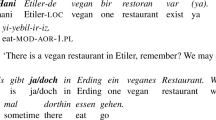Abstract
The Japanese toki-clause, a kind of temporal adverbial clause, exhibits several interesting properties regarding the semantic interpretation and selection of an embedded tense form. This paper argues that toki is ambiguous in three ways and may indicate three different temporal relations between the matrix eventuality (ME) and the subordinate eventuality (SE): (i) ME is simultaneous with SE (the WHEN-interpretation), (ii) ME is immediately prior to SE (the RIGHT BEFORE-interpretation), and (iii) ME is immediately subsequent to SE (the RIGHT AFTER-interpretation). Problems with existing analyses that seek a uniform treatment of toki will be pointed out, and it will be demonstrated that the proposed analysis provides a thorough and consistent account of the possible interpretations of toki-clauses under different conditions.
Similar content being viewed by others
References
3A Corporation, ed. 1998. Minna no nihongo I: English translation and grammatical notes. Tokyo: 3A Corporation.
Banno, Eri, Yutaka Ohno, Yoko Sakane, Chikako Shinagawa, and Kyoko Tokashiki. 1999. Genki: An integrated course in elementary Japanese. Vol. 2. Tokyo: The Japan Times.
Comrie Bernard. (1976) Aspect: An introduction to the study of verbal aspect and related problems. Cambridge University Press, Cambridge
Funahashi Mizuki. (2006) Tokisetu no kaisyaku ni kansuru rironteki koŝatu [Pragmatic factors in the interpretation of toki-clauses]. Nihongo bunpô 6: 106–121
Erhard Hinrichs. (1986) Temporal anaphora in discourses of English. Linguistics and Philosophy 9: 63–82
Inoue, Kazuko. 1976. Henkei bunpô to nihongo: Ge [Transformational syntax and Japanese: Part 2]. Tokyo: Taishukan.
Inoue, Kazuko, ed. 1989. Nihongo bunpô syôziten [A small encyclopedia of the Japanese grammar]. Tokyo: Taishukan.
Iwasaki Shoichi (2002) Japanese. Volume 5 of London Oriental and African language library. John Benjamins, Amsterdam
Lewis S. Josephs (1972) Phenomena of tense and aspect in Japanese relative clauses. Language 48: 109–133
Kamp, Hans, and Uwe Reyle. 1993. From discourse to logic: Introduction to modelthoretic semantics of natural language, formal logic and discourse representation theory. Dordorecht: Kluwer.
Kaufmann Stefan, Miyachi. Misa (2008) On the temporal interpretations of Japanese temporal clauses. Ms. Northwestern University, University of Chicago
Kubota, Yusuke, Lee Jungmee Lee, Anastasia Smirnova, and Judith Tonhauser. forthcoming. Crosslinguistic variation in temporal adjunct clauses. In Cahiers Chronos: Selected proceedings of Chronos 8. Amsterdam: Rodopi.
Kudo, Mayumi. 1995. Asupekuto/tensu taikei to tekusuto: Gendai nihongo no zikan no hyôgen [Aspect/ tense systems and text: Temporal expressions in modern Japanese]. Tokyo: Hituzi Shobo.
Kuroda, S.-Y. (1992). Japanese syntax and semantics: Collected papers. Dordorecht: Kluwer
Machida Ken. (1989) Nihongo no zisei to asupekuto [Tense and aspect in Japanese]. ALC, Tokyo
Masuoka Takashi. (1997) Hukubun [Complex sentences]. Kurosio, Tokyo
Mihara, Ken-ichi. 1992. Zisei kaisyaku to tôgo gensyô [Interpretation of tenses and syntactic phenomena]. Tokyo: Kurosio.
Mihara, Ken-ichi, and Miwa Hamada. 1996. Rentai syuŝyokugata hukusi setu no tensu [Tenses in nounmodifying adveribal clauses]. In Nihongo/nihon bunka kenkyû, Vol. 6, 31–41. Osaka University of Foreign Studies.
Moens Marc, Mark Steedman. (1988) Temporal ontology and temporal reference. Computational Linguistics 14(2): 15–28
Ogihara Toshiyuki. (1996) Tense, attitudes, and scope. Kluwer, Dordrecht
Oshima, David Y. 2009. Perspective, logophoricity, and embedded tense in Japanese. In Japanese/Korean linguistics, ed. Yukinori Takubo, Tomohide Kinuhata, Szymon Grzelak, and Kayo Nagai, Vol. 16, 481–495. Stanford: CSLI Publications.
Palmer Frank R. (2001) Mood and modality. 2nd ed. Cambridge University Press, Cambridge
Pylkkänen Liina, Rodolfo Llinaś, Gregory L. Murphy. (2006) The representation of polysemy: MEG evidence. Journal of Cognitive Neuroscience 18: 97–109
Rothstein, Susan. 2004. Structuring events: A study in the semantics of aspect. Oxford: Blackwell.
Shioiri, Sumi. 1998. Toki to tokini to toki(ni)wa: Toki o arawasu zyûzoku setu no syudaika keisiki to hisyudaika keisiki [Toki, tokini, and toki(ni)wa: Topicalized and untopicalized forms of temporal subordinate clauses]. In Nihongo ruigi hyôgen no bunpô: Ge [Grammar of synonymous expressions in Japanese: Part 2], ed. Tatsuo Miyashima and Yoshio Nitta, 539–547. Tokyo: Kurosio.
Smith, Carlota S., ed. 1997. The parameter of aspect. 2nd ed. Dordrecht: Kluwer.
Sunakawa, Yuriko. 1986. Suru/sita/siteiru [Suru/shita/shiteiru]. Vol. 2 of Nihongo bunpô serufu masutâ. Tokyo: Kurosio.
Sunakawa Yuriko, Satoshi Komada, Mitsuko Shimoda, Mutsumi Suzuki, Sayo Tsutsui, Akiko Hasunuma, Andrej Bekes, Junko Morimoto (1999) Kyôsi to gakusyûsya no tame no nihongo bunkei ziten. [A dictionary of Japanese phrase patterns for teachers and learners], Tokyo: Kurosio
Teramura, Hideo. 1999. Teramura Hideo ronbunsyû [Collected papers of Hideo Teramura], Vol. 1. Tokyo: Kurosio.
Tohsaku Yasu-Hiko. (2006) Yookoso!: Continuing with contemporary Japanese. 3rd ed. McGraw-Hill, New York
Tomomatsu, Etsuko, Jun Miyamoto, Masako Wakuri. (2007). Donna toki dô tukau nihongo hyôgen bunpô ziten [Dictionary of essential Japanese expressions: A guide to correct usage of key sentence patterns]. ALC, Tokyo
Yoshimoto, Kei, and Yoshiki Mori. 2002. A compositional semantics for complex tenses. In The proceedings of the 8th International Conference on Head-Driven Phrase Structure Grammar, ed. Frank van Eynde, Lars Hellan, and Dorothee Beermann, 300–319. Stanford: CSLI Publications.
Author information
Authors and Affiliations
Corresponding author
Rights and permissions
About this article
Cite this article
Oshima, D.Y. On the interpretation of toki-clauses: beyond the absolute/relative dichotomy. J East Asian Linguist 20, 1–32 (2011). https://doi.org/10.1007/s10831-011-9071-6
Received:
Accepted:
Published:
Issue Date:
DOI: https://doi.org/10.1007/s10831-011-9071-6




